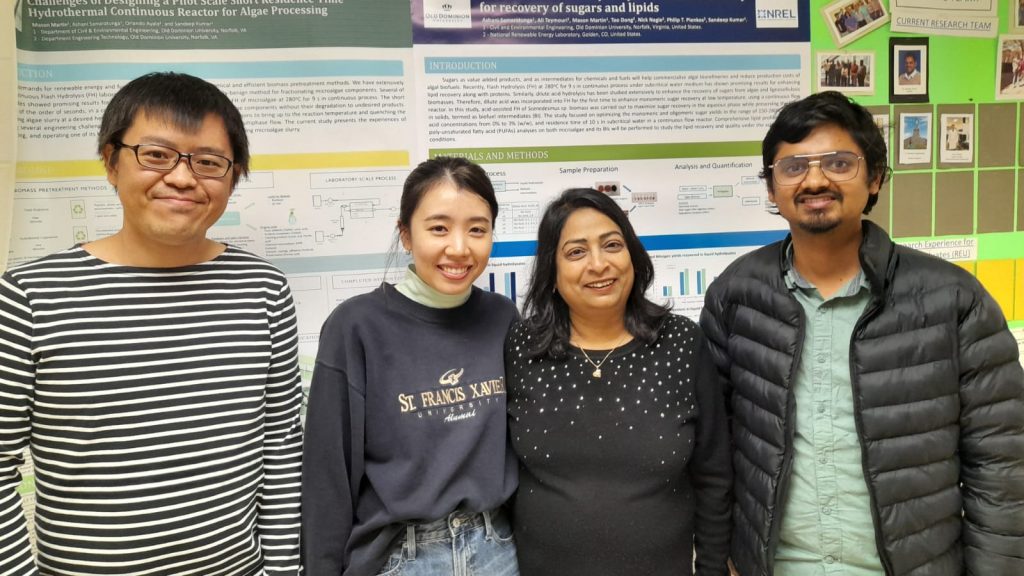- Removal of copper and cadmium from aqueous solution using switchgrass biochar produced via hydrothermal carbonization process
- Flash hydrolysis of microalgae (Scenedesmus sp.) for protein extraction and production of biofuels intermediates
- Kinetics of arginine and soluble peptides production from microalgae using flash hydrolysis
- Flash hydrolysis of microalgae for on-site nutrients recovery and biofuels production (EPA P3)
- Nutrient recovery and recycle of algal biomass after harvesting
- Activated carbon production via pyrolysis of impregnated lignocellulosic biomass
- Bio-oil via catalytic liquefaction of unhydrolyzed solids in aqueous medium
- Hydrothermal treatment for enhancing oil extraction and hydrochar production from oilseeds
- Hydrothermal catalytic hydrogenation and decarboxylation of fatty acids in continuous flow process
- Hydrothermal processing of mixed feedstocks and anaerobic digestion
Biolubricants for Plant Materials
The Biomass Research Laboratory, under the supervision of Dr. Sandeep Kumar, is developing a process of preparing biolubricant from unhydrolyzed solids (lignin) in collaboration with Montana State University-Northern. This project is funded through the United States Department of Agriculture (USDA).
Lignocellulosic ethanol biorefineries offers a sustainable way to produce alternative fuels and provide fiber and biomaterial, but lignin fraction (unhydrolyzed solids) remains underutilized in the absence of development of high-value products. The team has proposed that lignin must be first decomposed into high concentration of phenol and alkylphenols then selectively transform these phenolic derivatives into a compound with a chemical structure fit for its purpose as biolubricant. Hydrothermal liquefaction of wet unhydrolyzed solids (UHS), a by-product of lignocellulosic ethanol production, generates bio-oil with 98% phenolic compounds which more than half of it is phenol and alkylphenols. This phenolic bio-oil is upgraded into aromatic hydrocarbons via hydrodeoxygenation then selectively converted into a lubricant improver by alkylation with fatty acid methyl esters. This lignin-based product has the chemical structure that makes the product suitable lubricant improver, an additive that improves lubricity of fuels and lubricants. The arrangement of reactions allows to utilize lignin and develop new products adding value to lignocellulosic ethanol. Analysis of the reaction mechanisms and kinetics, such as alkylphenol hydrodeoxygenation and aromatic alkylation, and evaluation of the overall process life cycle will help to understand how to synthesize sustainable lignin-based lubricant improver and how to integrate this process to the production of lignocellulosic ethanol.

EPA: P3 (People, Prosperity, Planet) Research
Low-cost Household Biochar Water Filter for Lead Removal (2017-2018)
The major challenge of using biochar as a cost-competitive method is to assess what quantity of lead a given amount of biochar can adsorb before supersaturation in a continuous flow packed-bed system. Adsorption of a substance involves its accumulation at the interface between two phases. Breakthrough: the point at which all adsorption sites are occupied adsorbate and adsorbent are in equilibrium, of a given amount of biochar data can be used to design a household water filter for drinking water free of lead contamination. This P3 award team proposes to design a biochar filter for the removal of lead from tap water using the principle of adsorption based on the schematics shown in Figure 1.1 for real applications.

This project will follow the below goals:
Goal1: Theoretical investigation will be performed on the proposed filter. The research will focus on breakthrough point calculation, material selection, and efficiency evaluation
Goal 2: The research team will build a prototype of a biochar filter to evaluate the practical lead removal potential of the proposed concept.
Goal 3: The research team will demonstrate the efficiency of the filter in eliminating lead from supplied household water
This filter is designed for ease of use for any person that may need it. To meet this goal the schematic (Figure 1.1) demonstrates how the product is envisioned: simple installation of filter, mounting onto the faucet, and replacement of the filter cartridge as needed. Under-the-counter filters can also be produced for those that are not in need of immediate use; a product designed for longevity rather than providing potable water in emergency situations. Materials will be inexpensive to ensure convenience for those in need and are available for shipment to areas of crisis. Plastics manufacturers can be utilized for mass production and the use of char, as opposed to GAC, will also reduce cost. To guarantee operational design, additional testing and refinement are necessary to secure an appropriate factor of safety.

Flash Hydrolysis of Microalgae for On-site Nutrients Recovery and Biofuels Production (2014-2015)
Some of the major challenges in accomplishing the objective of cost-competitive biofuels production from microalgae include dewatering, high nitrogen/protein content, and diverse composition of microalgae. In view of challenges associated with utilizing this high-water content biomass, principally the need for water and nitrogen removal, reactions in subcritical water (critical point: 374°C, 22.1 MPa) medium may be an attractive option for extracting valuable bioactive compounds and producing liquid hydrocarbons from microalgae. In subcritical water-based processes, water is kept in the liquid phase and so the latent heat required for phase change of water from liquid to vapor (2.26 MJ/kg) is avoided. This allows reducing the energy requirement for the subcritical water-based process compared to that of steam-based processes. The entire proposed hypothesis is represented in the following schematic.

The P3 award team proposes to build and operate a flash hydrolyzer. It is a plug flow type rector which operates between 150-320°C under subcritical water conditions and is capable of processing 100 gallons per hour of algal slurry with tunable residence time. The residence time is very short (2 to 30 s) which allows us to use a compact continuous plug flow reactor. Based on our preliminary experimental study, it was estimated about 70 wt% (dry basis) of nitrogen is present in microalgae as proteins can be hydrolyzed as peptides and amino acids. During the process, about 30% of carbon present in microalgae is also hydrolyzed and becomes part of the liquid stream.
